If you drive along the road at Sandakan, Tawau and Lahad Datu, you will see an endless sea of oil palm, instead of scenic countryside covered with lush forest. Funny thing is – Tourism Malaysia setup some ad billboards, right in front of some oil palm plantation, portraying Sabah as the ecotourism destination. The disappointed tourists would ask, “is oil palm your primary forest?” The oil palm plantation is such an eyesore, whenever I know that it is strongly linked to the miserable haze that attacks our land every year. Indonesia has been a lousy neighbour and Kalimantan seems to have problem to stop farmers to clear the land by burning forest. A predict mentions Kalimantan will lose all its rainforest within 3 years. Great! They will have Nothing to burn soon.
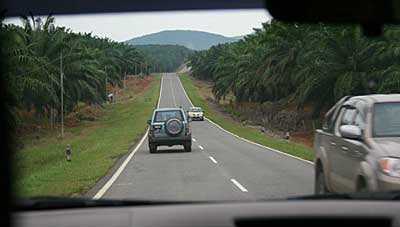
Hundreds square miles of land in Sabah is now an ecology desert. Now this tree is invading area such as Pitas and next to new road from Keningau to Tawau. Trying to fool us that our forest conservation is doing great, government declares 12 new forest reserves earlier. Do you know that our forest reserves are surrounded by oil palm? So these forest reserves do not connect to one another and each reserve becomes an isolated island. Wildlife is locked in small patches of fragmented forest so they can’t move to other reserves for food and breeding. Orang-utan, pygmy elephants and rhino cannot migrate anywhere else.
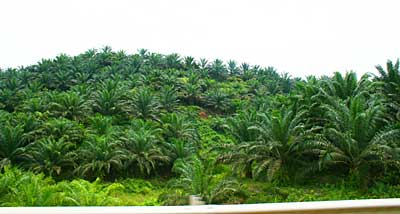
Musa Aman said National Geographic praised Sabah has done a marvelous job in protecting the forest. Bull shit! I have read the article and National Geographic only said Sabah is not as corrupted as Sarawak and Kalimantan, so our conservation is only “slightly” better off than Sarawak. Just read the National Geographic article below:
Click Here to read the full article “Borneo’s Moment of Truth” by National Geographic and judge it yourselves.
Some extracts from the article..
| But if you want to see the real Borneo, the Borneo of the first decade of the 21st century, it would be good to be the crested serpent-eagle perched in a tree across the river. Then you could soar high above the Kinabatangan [of Sabah] and see how quickly the unruly forest gives way to neatly planted rows of oil palm trees, stretching for mile after mile in all directions. The palm plantation is lush and green, and the arching fronds of the trees give it an exotic beauty, and for the incomparable biodiversity of Borneo it is inexorable death.
“Virgin rain forest is a dead concept now in Borneo,” says Glen Reynolds, chief scientist at the Danum Valley Field Center in Sabah. “All of the big areas of primary lowland forest that can be conserved already have been. The natural world fares better in Sabah, the Malaysian state in northeastern Borneo. Though oil palm plantations have burgeoned here, more than half of Sabah remains forested. Much of the forest has been heavily logged, and more and more acres converted to commercial tree plantations, but Sabah sustains some of the best surviving examples of high-quality rain forest: the Danum Valley and Maliau Basin Conservation Areas… …It retains some of the best rain forest on Borneo, but, since it occupies less than one percent of the island, it makes a negligible contribution to the overall conservation picture. “… So you can log forests and still save that biodiversity. But the thing you can’t do is convert the whole thing to monoculture plantations,” such as oil palm. “Then of course you lose everything. It’s a biological desert.” WWF geographer Raymond Alfred shows me around Sabah’s state-owned Ulu Segama Forest Reserve, where the forest has been thoroughly—and legally—logged, leaving woodland that seems downright puny compared with the skyscraping rain forest at nearby Danum Valley. |
From the coal power plant, expensive Mt Kinabalu climbing fee and oil palm cases, by now we should aware that foreigner organisations do not love our land, so we should learn to love our land and protect it ourselves, instead of counting on government who loves those big companies and disregard the warning from citizens and NGOs such as WWF.
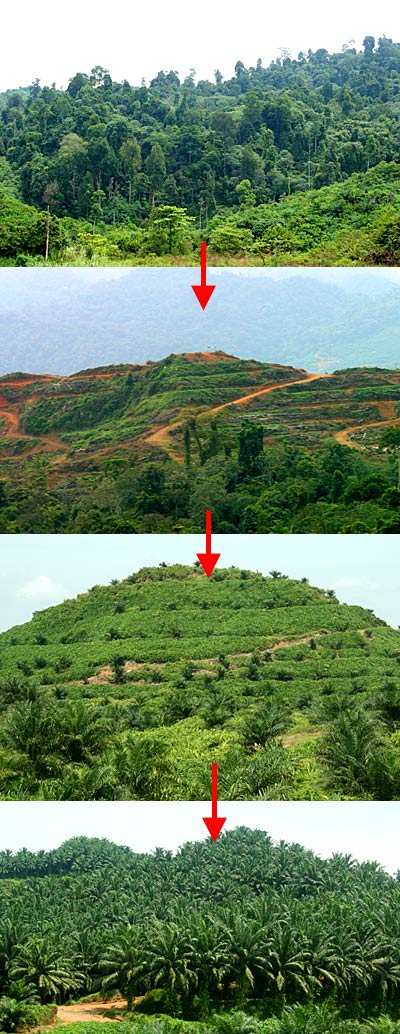
Undoubtedly, oil palm plays an important part in our economy. Oil palm itself is not a “sinful” crop. However, it is only the way oil palm companies plant it cause a lot of environmental problems. Hopefully, they will strictly follow the Roundtable Sustainable Oil Palm (RSOP) guidelines to strive for a balance between profit and environment. The western media like to point fingers at the negative impact of oil palm in our country. But they should realise that their countries want cheap palm oil instead of costlier palm oil produced under RSOP. So please stop to be hypocrite.
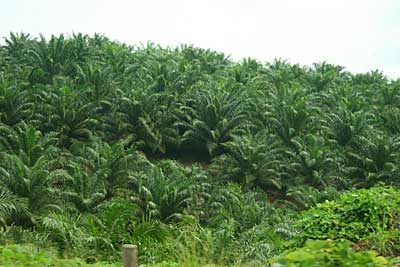
Everyone knows the recent storm “Morakot” flooded half of Taiwan, and landslide killed many people and some area was buried under 4 and 5 floors of soil and rocks! The Taiwan government acknowledges that the disaster was caused by over-development of hill area. Our government attitude is very different though. When over-logging caused flood in Tenom and weak hill structure made whole housing collapsed, they just attributed these as “Act of God”. And as usual, no government officer need to be held liability. When the slope is clear, the rain will wash the soil into the river causing a shallow and narrow river. One day, if the rain is pouring and the developed hill can’t hold the water as effective as hill forest, big flood will happen.
According to State Forest Enactment, any development and farming is prohibited on the slope steeper than 25 degrees I think? However, I saw many many steep slopes are clear for planting of oil palm. Isn’t it illegal? Hill development was asked to be stopped many times. But who are still approving such projects? One day when tragedy like Morakot happens (touch wood!), you will not surprise to hear government says that such man-made disaster is Act of God again. Good luck!

Clearing of forest for oil palm plantation is a win-win situation. Timber companies got their wood, oil palm companies can use this clear land to plant cash crop, and you all know, some politicians and government officers will win fat cash under table. The losing side is the rakyat (citizens), who will get flood and pollution. 90% of workers in plantation are cheap labour from foreigner countries, so this industry does not create many job opportunities for locals like government claims. FYI, the oil palm companies love our rainforest soil, coz it almost doubles the yield of oil palm.
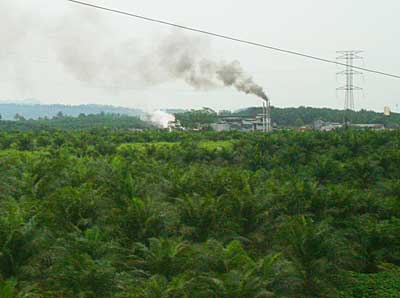
After 308, anyone who still believe Barisan Nasional government is an idiot. Remember Musa Aman asked the plantations, which encroached the river side of Kinabatangan, removed their trees or “faced the music”? He said it twice on the newspapers in 2004 and 2007. But anything happened? No. He was really singing only. The encroaching oil palm are still there. Furthermore, the oil palm mills still dump tons of toxic chemicals into the Kinabatangan River. Many fishes die and the water is getting dirtier to drink, affecting thousands of locals who rely on the river.
Zoom in the photo above and you will see one of the ocean of oil palm, scary… Sabah is becoming the Land below Oil Palm. This is a common scene in Lahad Datu.
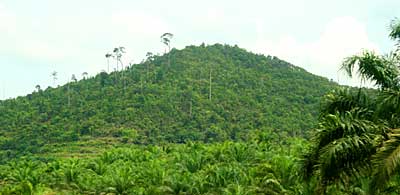
Above is a forest reserve being surrounded by oil palm. Isn’t this so-called forest reserve look more like an island?
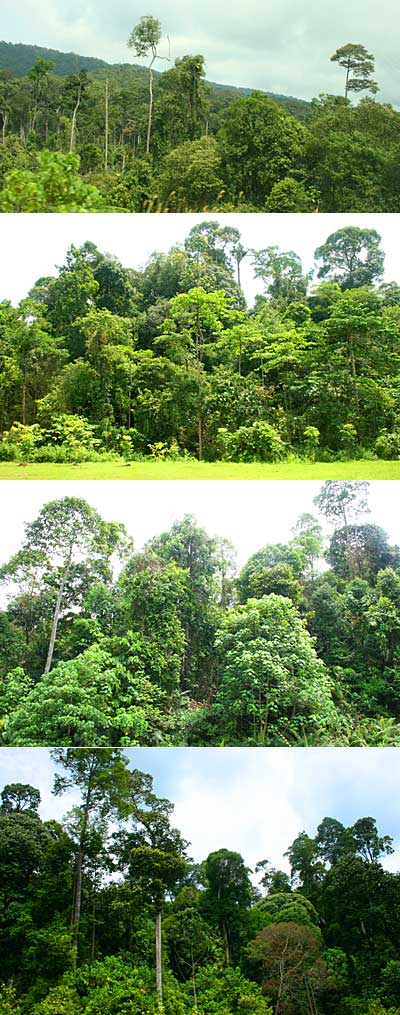
Before the land was clear for oil palm plantation, there are beautiful forest with tall trees like photo above. These trees survive because these trees are in forest reserve, but is nothing if compared to the size of oil palm land next to it.
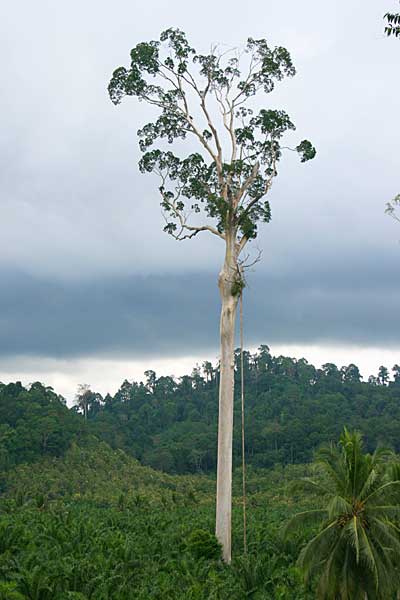
Looking at the photo above, may be you wonder why this tall tree in the oil palm land was not cut down. Usually the oil palm planters will purposely keep a few tall trees in the farm, but not for conservation. This tree is for bird predators such as eagle and owl to rest on, so they can help the planters to control the pest such as rats. What an exploit.. However, this tree does remind us that this land was once covered by many big trees like this. Malaysia Palm Oil Council (MPOC) claimed that no new forest areas had been allocated for planting oil palm since 1990. The photos here prove that they are liar.
Photos taken in Sabah, Malaysia Borneo
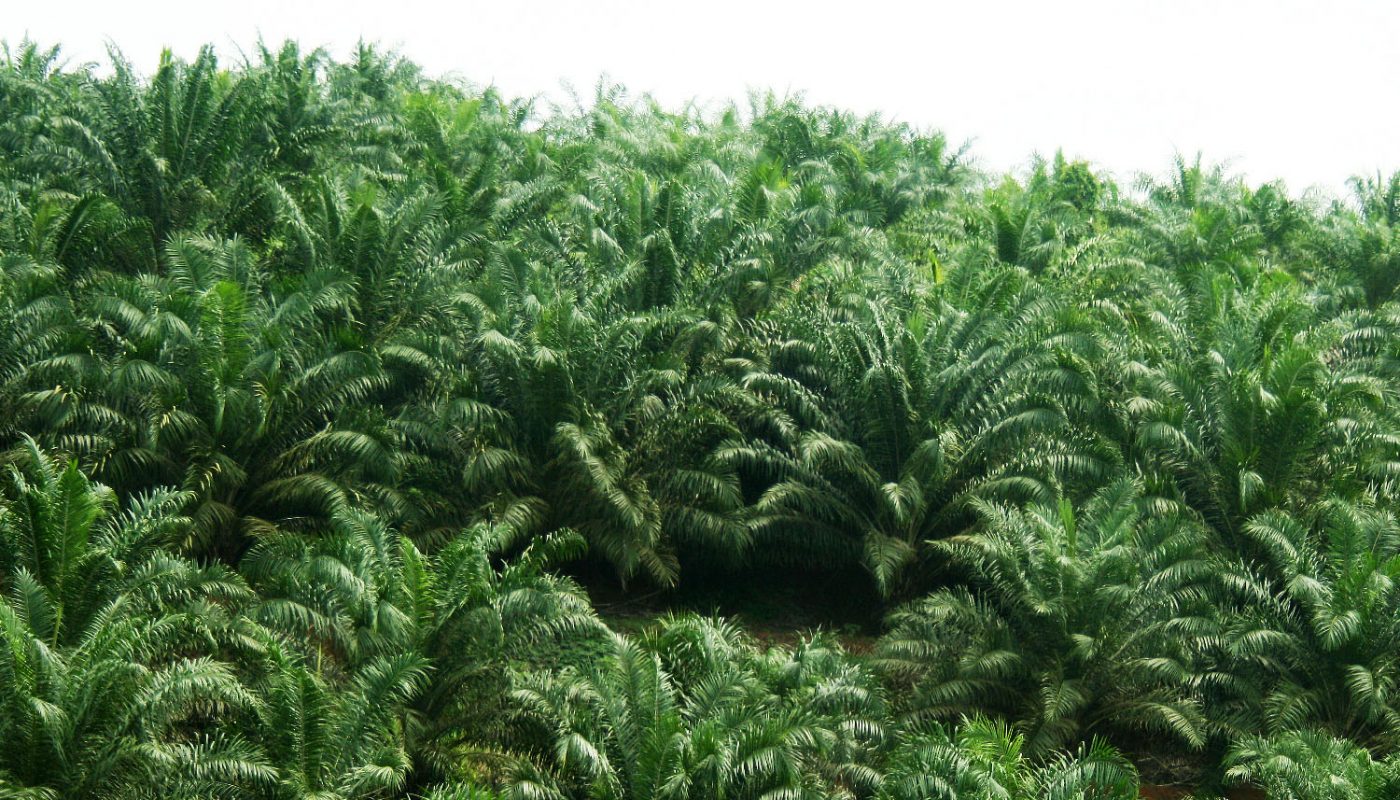

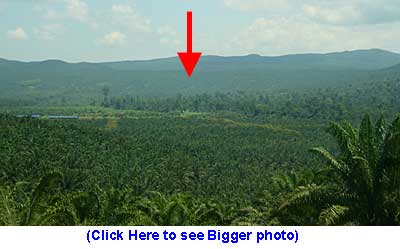
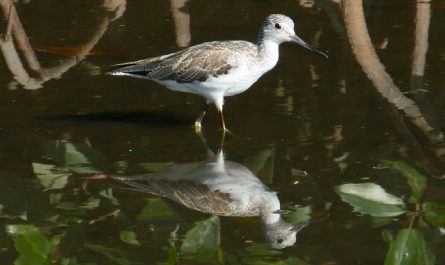

Great write up! Thanks for the awareness. I too look forward for the day when the people in power care less for their pockets and start to see Sabah’s real treasures.
It will still be a while for that… 🙁
Didn’t expect it to be that serious in Sabah yet. Hope those in the positions to change something will soon realize it.
Thanks for all your help planning my trip!
Hi, a number of Sabah agronomists and agriculture scientists have expressed to me of the grave concern that Sabah is putting an inordinately large number of eggs in a single (oil palm) basket. History has shown that a crop disease epidemic (bananas, pineapple, potatoes, papayas, cotton) can decimate an industrial crop at one sweep. There is evidence of an oil palm disease although it is not highly contagious at the moment.
Hi Rae, I totally agree with you. like cocoa plantation in early day of Tawau, it was very profitable and fetched very high price in market, just like our palm oil today. Then a pest came and destroyed most of them in 80s. now it is a half-dead business.
Memang betullah Sabah sekarang bukan lagi ‘The land below the wind’ dan sekarang sudah jadi ‘Land Below Oil Palm’. Kalau kita jalan dari Ranau, Telupid, Sandakan, Kinabatangan, Lahad Datu, Semporna dan Tawau….sepanjang jalan ialah SAWIT. Di Ranau sekarang pun…dashyat ooo….banyak bukit telah dibersihkan untuk penanaman SAWIT.
Cuma pendapat saya pembangunan pertanian ni harus diseimbangkan dengan pemuliharaan hutan untuk water catchment dan keseimbangan ekosistem. Pemuliharaan hutan ni penting….dalam memelihara habitat flora dan fauna yang unik di Sabah. Unik termasuklah spesies-spesies serangga, haiwan vertebrate, bunga-bungaan dsbnya endemik di Borneo (hanya wujud di Borneo). Contohnya, orkid..Sabah sangat kaya dengan orkid-orkid yang endemik dan bayangkanlah orang-orang luar selalu datang curi orkid kita…dengan bermacam-macam cara…..Dan jika kita memulihara alam sekitar, banyak manfaatnya dan negeri kita bebas dari banjir kilat, banjir lumpur, tanah runtuh dan bermacam-macam bencana alam. Menurut sumber dari geologist, tanah di Sabah ni masih dikategorikan ‘muda’ dan berpasir. Tu yang jalan-jalan raya kita ni selalu masuk-masuk dalam dan berlubang-lubang. Hutan berupaya untuk memegang tanah dan mengelakkan dari berlakunya semua perkara yang tidak diingini tu. Pendapat saya pembangunan tanpa keseimbangan ekosistem akibat penebangan hutan berleluasa selalunya bakal mengundang masalah pencemaran dan bencana alam yang kosnya boleh menelan belanja sangat besar berbanding kos untuk pembangunan kawasan seperti yang telah berlaku di kebanyakan negara lain. Kesimpulannya, tanam SAWIT tu pun mesti berpada-pada juga walaupun ia sekarang adalah punca pendapatan ekonomi negeri SABAH.
Thank you amer for your wise comments. i totally agree with you.
I remember every time me and my family go to visit relatives in Tawau from Lahad Datu, the surrounding of the journey was like rain forest – oil palm all the way -then forest and oil palm again.
I hope the leaders would be aware and fight to reserve the forest cause it’s our heritage for our future generation.
Awesome writing btw..
I have some friends in the logging business in Sabah. The government let the logging companies to own the land for 99 years on the condition that after they chop down trees, they must plant it back. But West Malaysia Loggers does not do this at all.
It’s a shame that many forest are cleared to make way for oil palm plantation. Hope that there would be more forest reservation before it’s too late.
Hi J.W, yes, the environmentalists here say the forest management plan is government’s biggest scam to our conservation. i always want to say it but i have no evidence. glad you confirm this fact.
Not only that forest are cleared for palm oil but there are cases where illegal clearings of the forest are done by the squatters.
MySabah.com, I’ve no evidence about the conservation either, but the few logging companies I knew are really involved in the replanting the logging areas, it takes years to bring back profits, but these things needs to be done.
Wished I can contribute in some ways to the forestry conservations. Rain forest is one of our heritage, I would hate to see it ruined.
Hi Janet, I totally agree with you. The planters encroach into forest reserve. when the authority enforces the law by cutting down their oil palm, they will cry foul and say the land is theirs. Do you know that many of such people are living in big house and driving big car?
J.W> it’s a great thing to hear. hope things will get better, so we could hand over the natural heritages (in good shape) to our future generations.
there are many we can do. start from the habit of reduce, recycle and reuse our stuffs. making donation to NGOs such as WWF, or tell (educate) others our thought.. just to list a few. saving our planet is a life-long battle against human greed..